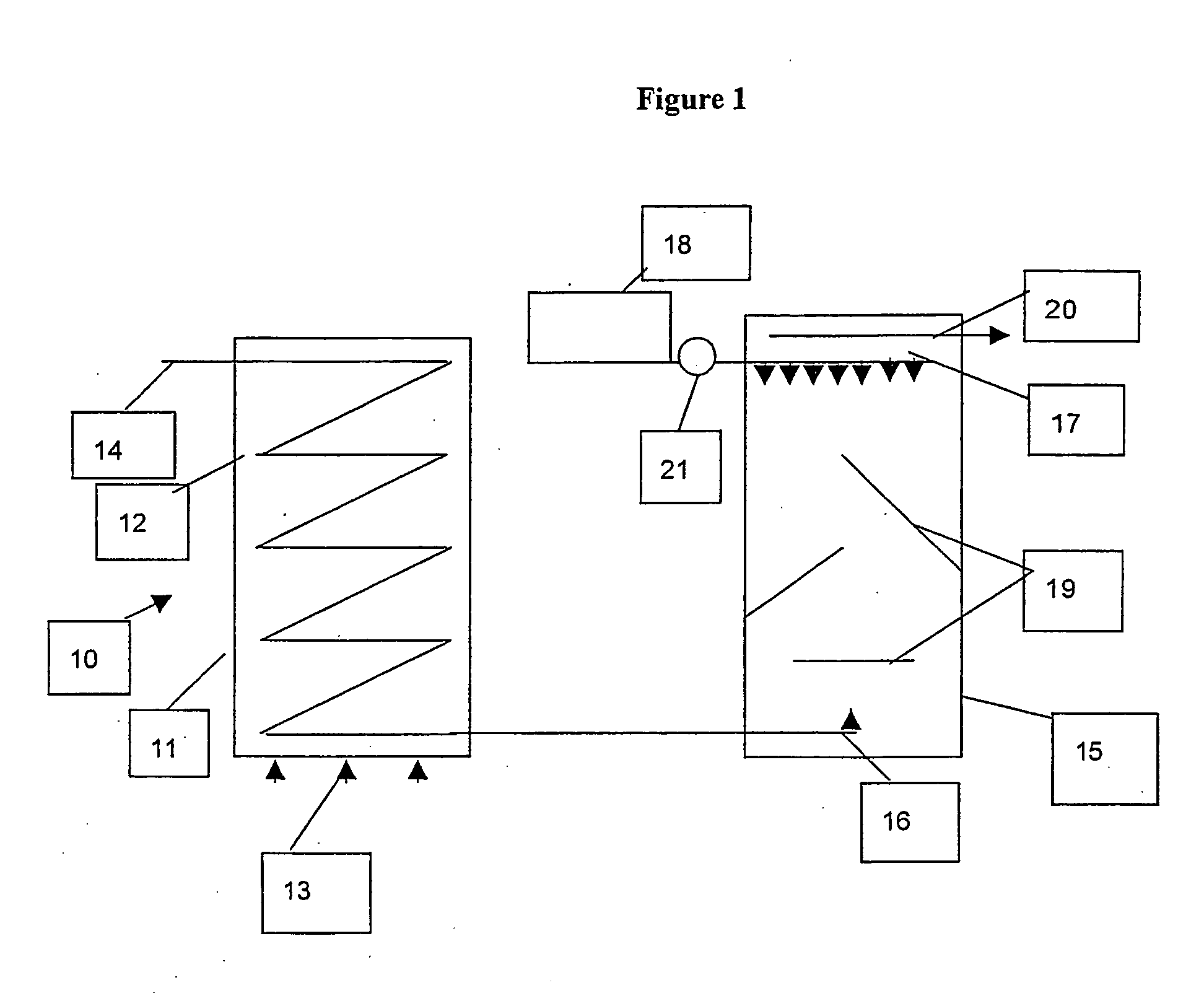Potentiation of microbial lethality of gaseous biocidal substances
a biocidal substance and microbial technology, applied in the field of microbial lethality of gaseous biocidal substances, can solve the problems of inconvenient mapping process, high cost, and limited extension, and achieve the effect of reducing the cost of specialised co-laminate film packaging, and reducing the cost of specialized packaging
- Summary
- Abstract
- Description
- Claims
- Application Information
AI Technical Summary
Benefits of technology
Problems solved by technology
Method used
Image
Examples
example 1
Temperature Rise on a Foodstuff From a Heated Gaseous Biocidal Substance
[0084] Cocktail Frankfurts (sausages) were treated with a heated gaseous biocidal substances (see Table 1) and the surface temperature rise was determined using a RAYTECH RY-MID-10LT infrared temperature sensor.
1TABLE 1 Treatment of Cocktail Frankfurts Foodstuff Frankfurts - 25 grams Acetic acid / CO2 gas mix @ 0.1 g / l First Gas Temperature (.degree. C.) 36.0 Second Gas Temperature (Additional Heating) 129.0 (.degree. C.) Flow rate litres / min. 25.0 Temperature frankfurt prior treatment (.degree. C.) 18.1 Treatment time (seconds) 5.3 Temperature frankfurt immediately post treatment 22.1 (.degree. C.) Temperature frankfurt 60 seconds post treatment 18.3 (.degree. C.)
[0085] The treatment parameters were similar to Example 2 below, it was therefore expected that the surface temperature rise in the Example 2 would have been similar.
[0086] The 4.degree. C. temperature rise in the frankfurts that occurred within 60 secon...
example 2
Treatment of Frankfurt Sausages with Heated Biocidal Gas Mixture
[0087] Test treatments of frankfurts with an acetic acid / carbon dioxide biocidal gas mixture were conducted to determine the effect on microbial activity of post-heating.
[0088] Methods
[0089] Method 1: Standard Treatment
[0090] CO.sub.2 gas was passed through approximately 1.5 litres of 90% w / w acetic acid contained in a sparger of approximately 4 litres in volume at the specified flow rate and temperature as set out in Table 2. The gas was then passed through a rigid aerosol trap of approximately 4 litres in volume. The resultant biocidal gas mixture (which comprised acetic and carbonic acid dissolved in the CO.sub.2 gas and presumably invisible small particles of acetic acid suspended in the CO.sub.2 gas) was then directed in to a plastic bag (with an internal volume of approximately 1.6 litres) containing a frankfurt sausage to the specified contact time (see Table 2). During this step, the bag and frankfurt sausage we...
example 3
Treatment of Frankfurt Sausages with Heated Biocidal Gas Mixture
[0102] Methods
[0103] Method 3: Standard Treatment
[0104] CO.sub.2 gas was passed through a sparger of approximately 3 litres in volume containing approximately 2.1 litres of >99.5% w / w acetic acid at the flow rate and temperature specified in Table 3, and then passed through a rigid aerosol trap of approximately 3 litres in volume. The biocidal gas mixture was then directed via an air heated line, heated to approximately 50.degree. C., into a plastic bag (with an internal volume of approximately 1.6 litres) containing a frankfurt sausage for a specified contact time (see Table 3). During this step, the plastic bag and frankfurt sausage were shaken in order to ensure intimate contact of the biocidal gas mixture with the entire surface of the frankfurt sausage.
[0105] Method 4: Modified Treatment with a Post Heated Biocidal Substance / Gas Mixture.
[0106] CO.sub.2 gas was passed through a sparger of approximately 3 litres in v...
PUM
| Property | Measurement | Unit |
|---|---|---|
| temperature | aaaaa | aaaaa |
| temperature | aaaaa | aaaaa |
| temperature | aaaaa | aaaaa |
Abstract
Description
Claims
Application Information
 Login to View More
Login to View More - R&D Engineer
- R&D Manager
- IP Professional
- Industry Leading Data Capabilities
- Powerful AI technology
- Patent DNA Extraction
Browse by: Latest US Patents, China's latest patents, Technical Efficacy Thesaurus, Application Domain, Technology Topic, Popular Technical Reports.
© 2024 PatSnap. All rights reserved.Legal|Privacy policy|Modern Slavery Act Transparency Statement|Sitemap|About US| Contact US: help@patsnap.com








